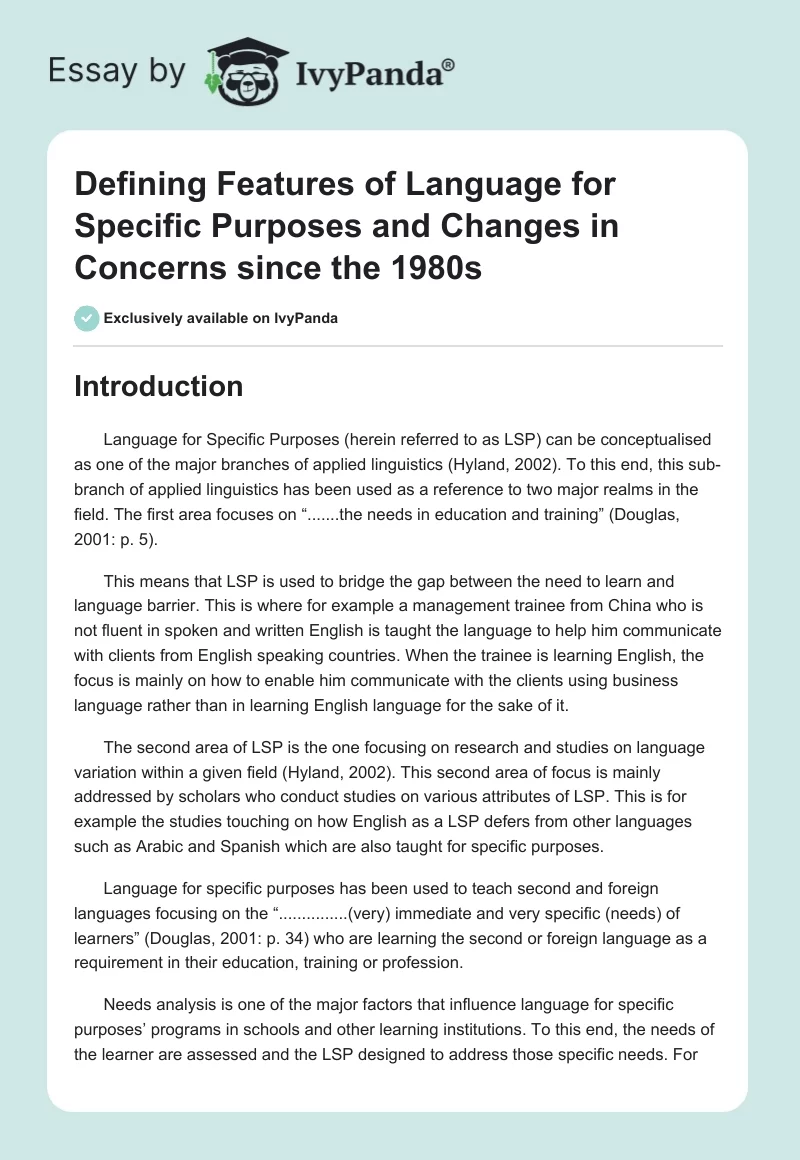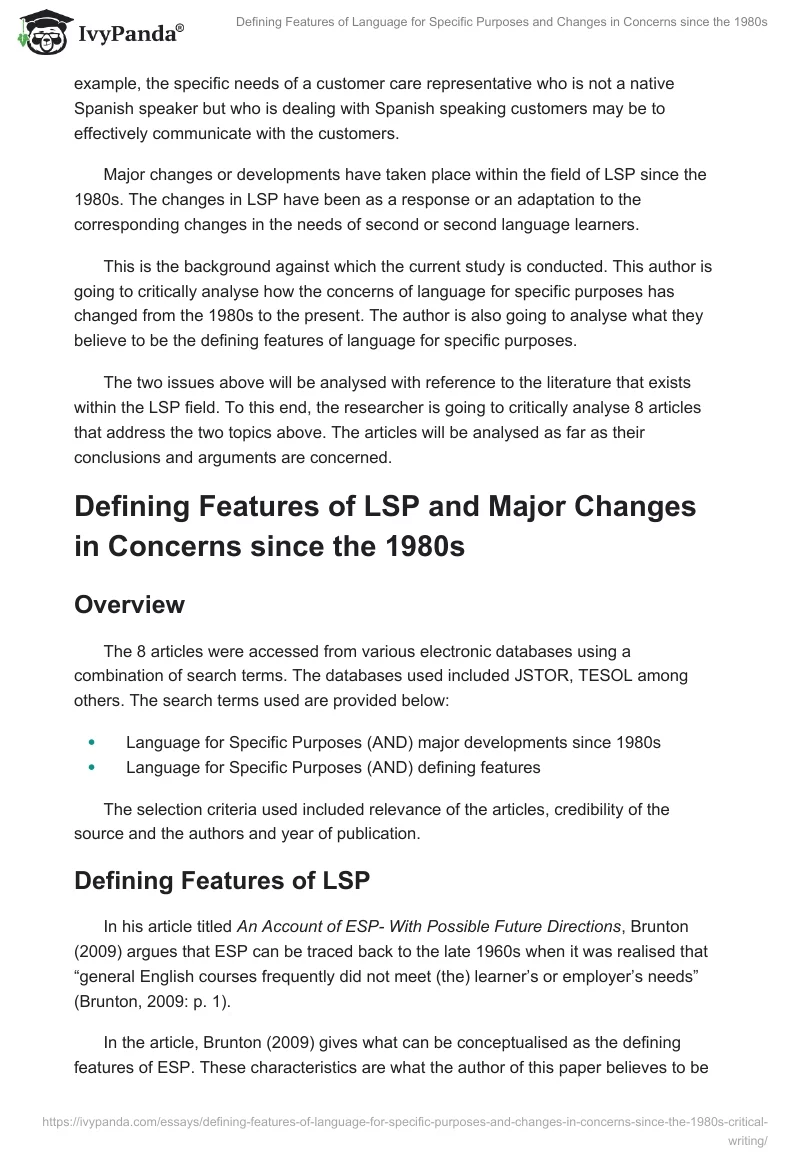Introduction
Language for Specific Purposes (herein referred to as LSP) can be conceptualised as one of the major branches of applied linguistics (Hyland, 2002). To this end, this sub- branch of applied linguistics has been used as a reference to two major realms in the field. The first area focuses on “…….the needs in education and training” (Douglas, 2001: p. 5).
This means that LSP is used to bridge the gap between the need to learn and language barrier. This is where for example a management trainee from China who is not fluent in spoken and written English is taught the language to help him communicate with clients from English speaking countries. When the trainee is learning English, the focus is mainly on how to enable him communicate with the clients using business language rather than in learning English language for the sake of it.
The second area of LSP is the one focusing on research and studies on language variation within a given field (Hyland, 2002). This second area of focus is mainly addressed by scholars who conduct studies on various attributes of LSP. This is for example the studies touching on how English as a LSP defers from other languages such as Arabic and Spanish which are also taught for specific purposes.
Language for specific purposes has been used to teach second and foreign languages focusing on the “……………(very) immediate and very specific (needs) of learners” (Douglas, 2001: p. 34) who are learning the second or foreign language as a requirement in their education, training or profession.
Needs analysis is one of the major factors that influence language for specific purposes’ programs in schools and other learning institutions. To this end, the needs of the learner are assessed and the LSP designed to address those specific needs. For example, the specific needs of a customer care representative who is not a native Spanish speaker but who is dealing with Spanish speaking customers may be to effectively communicate with the customers.
Major changes or developments have taken place within the field of LSP since the 1980s. The changes in LSP have been as a response or an adaptation to the corresponding changes in the needs of second or second language learners.
This is the background against which the current study is conducted. This author is going to critically analyse how the concerns of language for specific purposes has changed from the 1980s to the present. The author is also going to analyse what they believe to be the defining features of language for specific purposes.
The two issues above will be analysed with reference to the literature that exists within the LSP field. To this end, the researcher is going to critically analyse 8 articles that address the two topics above. The articles will be analysed as far as their conclusions and arguments are concerned.
Defining Features of LSP and Major Changes in Concerns since the 1980s
Overview
The 8 articles were accessed from various electronic databases using a combination of search terms. The databases used included JSTOR, TESOL among others. The search terms used are provided below:
- Language for Specific Purposes (AND) major developments since 1980s.
- Language for Specific Purposes (AND) defining features.
The selection criteria used included relevance of the articles, credibility of the source and the authors and year of publication.
Defining Features of LSP
In his article titled An Account of ESP- With Possible Future Directions, Brunton (2009) argues that ESP can be traced back to the late 1960s when it was realised that “general English courses frequently did not meet (the) learner’s or employer’s needs” (Brunton, 2009: p. 1).
In the article, Brunton (2009) gives what can be conceptualised as the defining features of ESP. These characteristics are what the author of this paper believes to be the defining features of LSP (including ESP). These characteristics or defining features are to be found in other articles such as those by Dudley & Maggie (1998) and Huckin (2003). The features are analysed below:
- Designing the program to meet “the specific needs of the (language) learner” (Dudley & Maggie, 1998: p. 4). This means that unlike other language programs or courses, LSP is designed to meet specific needs of the learner.
- ESP (and LSP) applies the major methodologies and processes common to the field within which it is taking place. In other words, LSP varies from one field to the other. This means that the strategy adopted in implementing an LSP program in medicine is different from that in business.
- The program focuses on the language that is most applicable or most suitable to the processes under consideration. This means that the program is specific to the task in hand (Gatehouse, 2001).
The major strength of this article is the fact that it gives a detailed account of the developments of ESP since the 1960s. This automatically captures the developments or changes in the concerns of ESP (and LSP) between 1980 and today which is the focus of this study. The article also addresses another major aspect of this study by providing the defining features of ESP (and LSP).
However, a major weakness of the paper is the fact that it is limited to ESP as one of the areas in language for specific purposes. It fails to address the teaching of other languages such as French and Spanish for specific purposes.
Changes in Concerns of LSP from the 1980s to the Present
As indicated above, LSP has undergone major changes since the 1980s. Brunton (2009) gives us one of the major changes in the concerns of this program during this time. The scholar argues that during its early stages of development (from the 1980s), majority of the instructors involved in teaching ESP used register analysis to design the various courses offered.
However, it was realised that the use of register analysis alone was unable to achieve the envisaged objectives of the course. As a result of this, it became necessary to design new courses to try and address these shortcomings. Such new approaches adopted included target situation analysis (Brunton, 2009: p. 2). This can be considered as one of the changes in the concerns of LSP from the year 1980 to the present.
In an article titled Developments in ESP: A Multi-disciplinary Approach, Dudley & Maggie (1998) analyse how ESP has developed and how it can be conceptualised and categorised. Dudley & Maggie (1998) also analyse the benefits of this program to the learner. This article is similar to that by Brunton (2009) above given that they both provide a detailed analysis of the major developments in this field and the defining features of ESP. The two articles also look at LSP from ESP’s perspective.
Another major change in the concern of LSP since the 1980s is in its purposes. According to Douglas (2001), the focus of the program has broadened over the years to encompass “……….an (ever) diversifying and expanding (range) of purposes” (p. 34). This can be attributed to what Brunton (2009) refers to as glocalisation of the linguistics’ world.
In an article titled Ingles Para Quimica e Ingenieria Quimica (English Translation), Pedro (2002) acknowledges that major changes in the concerns of LSP have taken place since the late 1980s. Pedro (2002) argues that ESP has emerged as one of the most significant branches of English Language Teaching since late 1980s. The scholar acknowledges the fact that major changes (especially the focus of the program) has taken place since then. The focus has shifted from the practitioner to the learner.
In an article titled Defining English for Specific Purposes and the Role of the ESP Practitioner, Laurence (2005) argues that ESP has undergone various transformations since the early 1960s. The developments are reflected in the increasing number of institutions of higher learning offering undergraduate and postgraduate programs in ESP.
Another change is the launch of international and peer-reviewed journals addressing ESP. These are journals such as TESOL and ESP: An International Journal (Laurence, 2009). These sentiments are supported by other scholars such as Bojovic (n.d) and Johns & Dudley (1991).
In an article titled English for Specific Purposes: International in Scope, Specific in Purpose, Johns & Dudley (1991) argue that ESP has emerged as a “…….viable and vigorous movement within the field of TEFL and TESL” (p. 297). This can be conceptualised as another major change in the concern of LSP. The argument concurs with those provided by Brunton (2009) and Dudley & Maggie (1998) above.
In her article titled Key Issues in ESP Curriculum Development, Gatehouse (2001) argues that a major concern of LSP that has changed since the 1980s has to do with the role of the practitioner. The scholar argues that the practitioner has emerged as one of the most significant stakeholders in ESP (and LSP).
On his part, Huckin (2003) in an article titled Specificity in LSP argues that there have been changes in concerns of LSP as far as the specific objectives are concerned since the 1980s. Huckin (2003) traces the controversy to the works of various scholars in the field.
Conclusion
In this paper, the author analysed how the concerns of LSP have changed from the 1980s to the present. The author also looked at the defining features of LSP. The two topics were addressed by critically reviewing 8 articles in the field. The author found that several changes have taken place as far as the focus of LSP program is concerned.
Other changes touch on the curriculum, objectives of the program, role of the practitioner among others. For example, there has been a change from register analysis to target analysis. This is to ensure that the needs of the target audience (the learner) are fully addressed.
References
Bojovic, M. (n.d). Teaching foreign language for specific purposes: Teacher development. Association of Teacher Education in Europe, 487-493.
Brunton, M. (2009). An account of ESP- With possible future directions. English for Specific Purposes, 3(24): 1-15.
Douglas, D. (2001). Language for specific purposes assessment criteria: Where do they come from? Language Testing, 18(2): 171-185.
Dudley, T. E., & Maggie, J. S. (1998). Developments in ESP: A multi-disciplinary approach. Cambridge: Cambridge University Press.
Gatehouse, K. (2001). Key issues in ESP Curriculum Development. The Internet TESL Journal, 7(10): 23-28.
Huckin, T. N. (2003). Specificity in LSP. IBERICA, 5: 3-17.
Hyland, K. (2002). Specificity revisited: How far should we go now? English for Specific Purposes, 21: 2-7.
Johns, A. M., & Dudley, T. E. (1991). English for Specific Purposes: International in scope, specific in purpose. TESOL Quarterly, 25(2): 297-301.
Laurence, A. (2005). Defining ESP and the role of the ESP practitioner. Web.
Pedro, A. F. (2002). Ingles para quimica e ingenieria quimica. Barcelona: Ariel.


